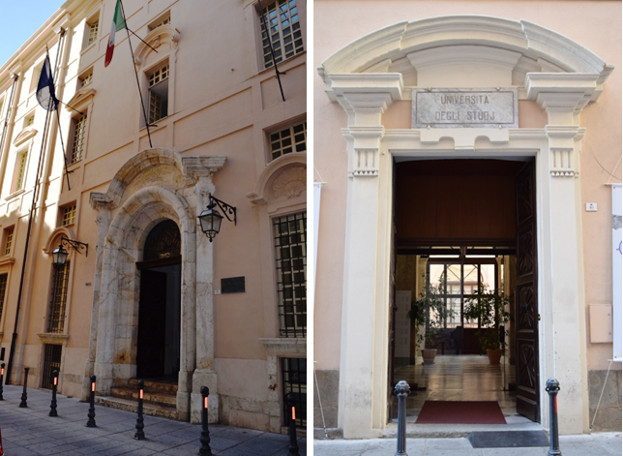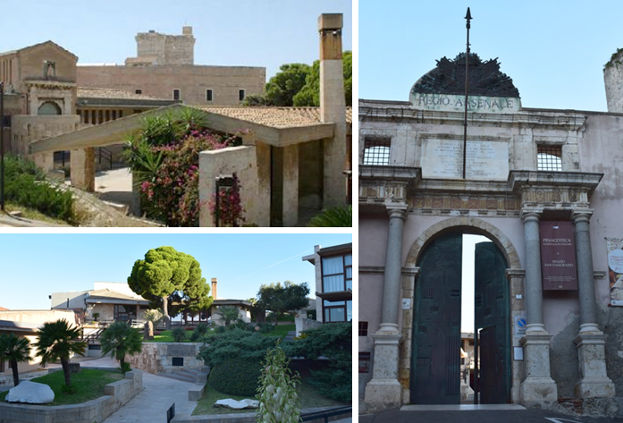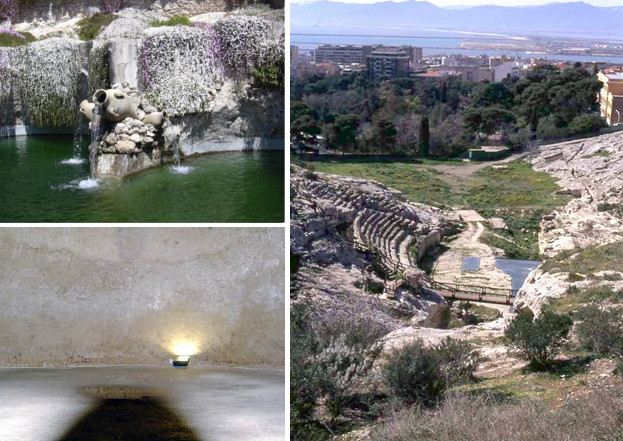

The Chancellor’s Office Building
The University building hosting the Chancellor’s Office was officially opened on 1st November 1769. It was designed by Saverio Belgrano di Famolasco and was one of the most important buildings constructed during the House of Savoy’s government in the 18th century. It was part of the so-called enlightened reforms that took place during the Piedmontese rule of Sardinia, and its construction changed the face of Cagliari’s city centre. The building’s long façade features a series of pilasters framing two doorways leading directly the Chancellor’s Office and the former Tridentine Seminary.
Many of the rooms in this building are very interesting from an artistic point of view. On the first floor, the Main Hall displays a painted decorative scheme and stuccowork on the ceiling and walls which date back to 1926, the year the renovation of the Main Hall was carried out entirely by the Sardinian painter Filippo Figari. On the ground floor, the 19th century frescoes on the ceiling of the Historical Archive are also worthy of note, along with the exhibition of the portraits of the Chancellors from the 18th century to date. They are displayed on the first floor, in the entrance hall that leads to the Chancellor’s Office.
The wing of the building that used to host the Tridentine Seminary still contains the Tridentine Chapel, featuring a richly frescoed barrel vault, an 18th century hall with its original wood furnishings, and the Luigi Piloni collection. The latter is an extremely valuable art collection donated to the University of Cagliari by Luigi Piloni in 1980. He was from Serdiana (in Sardinia) and worked at the Ministry of Public Works; Piloni was an art lover who devoted much of his time to researching the history of Sardinia. A total of 900 works are on display in seven different rooms. They include portraits of famous personalities who had a hand in the history of this island and a large number of paintings that help reconstruct the evolution of the visual arts in Sardinia from the 16th to the late 20th centuries. In addition, there is a unique collection of 140 geographical maps which are equally remarkable. These maps mainly feature Sardinia and its geography; along with prints depicting Cagliari, they form a invaluable resource that provides a historical framework for the way cartography developed in Sardinia and how its territory and capital city were reproduced from the 16th to the 19th centuries.

The Cittadella dei Musei
The Cittadella dei Musei is located in Cagliari’s city centre, in the old district called Castello. The area still boasts archaeological remains that can be traced back to the Punic and Roman eras. In the 14th century, the Maritime Republic of Pisa ruled the city and decided to reinforce the rocky buttress upon which the city was built. To this end, they constructed an imposing system of fortifications which were subsequently modified under the rule of the Spanish and the House of Savoy. Over time, the whole citadel retained its military function, being used first as the Royal Arsenal and later as a barracks as recently as the mid-1950s.
In the late 1960s, following archaeological excavations in 1966 that brought the earliest foundations of the citadel to light, the architects Piero Gazzola and Libero Cecchini were appointed to turn this historical complex into a site where the enormous heritage found in local museums and other important cultural institutions in Cagliari could be housed. These institutions include the National Archaeological Museum in Cagliari (
link
), the National Art Gallery (
link
), the Regional Ethnographic Museum and its Luigi Cocco Collection (
link
), the Stefano Cardu Collection on Siamese Art (
link
), and the Archaeology and History Section of the Department of History, Cultural Heritage and Territory of the University of Cagliari (
link
) , as well as three of its collections: the Lithic Collection [
GO TO THE COLLECTION ], the Evan Gorga Archaeological Collection [
GO TO THE COLLECTION
], the Evan Gorga Archaeological Collection [
GO TO THE COLLECTION ] and the Clemente Susini Anatomical Wax Collection (
link
) [
GO TO THE COLLECTION
] and the Clemente Susini Anatomical Wax Collection (
link
) [
GO TO THE COLLECTION ]
.
]
.
Negli spazi aperti e nei giardini sono esposti il busto di Giuseppe Peretti, Rettore dell’Università degli Studi di Cagliari (1955-1970) e fondatore della Cittadella dei Musei e opere dell'artista sarda Anna Saba. The open-air spaces and gardens host artwork as well, such as the bust of Giuseppe Peretti, Chancellor of University of Cagliari (1955-1970) and founder of the Cittadella dei Musei, and works by the Sardinian artist Anna Saba, along with the “Pietra Sonante” carved by Pinuccio Sciola. This sculpture was commissioned to celebrate the 2013 renaming of the Cittadella after Professor Giovanni Lilliu, a preeminent scholar of Sardinian archaeology who, in 1979, had been responsible for the opening of the then Institute of Antiquity, Archaeology and Art within the Cittadella complex. Lilliu also became the first director of this institute in order to “firmly link university teaching and research to the social role of museums, thus creating a ‘unified cultural whole’, which is an essential part of the building fabric and architectural design underlying the Cittadella itself”.

Hortus Botanicus Karalitanus
The Botanical Garden of the University of Cagliari (Hortus Botanicus Karalitanus) covers 5 hectares along the "Valle di Palabanda", a site of archaeological interest situated between the Roman Amphitheatre and the Villa di Tigellio. The area was acquired by the University in 1863 and the project was entrusted to the architect Gaetano Cima. Excavation works began in 1864 under the supervision of the founder, Professor Patrizio Gennari, the site was inaugurated on 15th November 1866. Professor Gennari was determined to acclimate plants from different geographical areas in order to produce bargaining chips for other botanical gardens as well as providing a local green areas: “a model Garden intended for local development of the horticultural industry, one of the best-located establishments in terms of climate, along with great plant acclimation expertise, a suitable nursery for the botanical gardens of the entire continent”.
In 1874 the first guide to the Botanical Garden “Guida dell’Orto Botanico della Regia Università di Cagliari” was published.
Within the site several archaeological finds are present, such as some Roman cisterns in good state of conservation, a Roman well with a water-lifting wheel (Noria), a clover-shaped water reservoir, the libarium cave which, dating back to Roman times and now dedicated to Patrizio Gennari, houses some luxuriant samples of Monstera deliciosa Liebm. and the Roman quarry where traces of a water system from the same period are visible. Two specimens of centuries-old Ficus macrophylla Roxb. et Buch.-Ham ex Sm. subsp. columnaris (C.Moore) D.J.Dixon cover this quarry and also provide a sheltered environment for a vast collection of ferns.
Thanks to its microclimatic characteristics, the garden has several different sectors, including the medicinal sector (Hortus Simplicium), the Mediterranean sector, the palm grove and the succulents sector, which exploits the natural suitability of the arid areas and the various rock outcrops. This latter sector also includes two greenhouses (Serra Martinoli and Serra Syrbe) and the “roccaglia” of biodiversity, which accommodates a collection of native, rare and/or endangered species of the western Mediterranean and of Sardinia.
The central path runs alongside three tanks where different types of aquatic plants grow. One of the tanks is populated by plants of the Nymphaea genus, among which the Nuphar lutea (L.) Sm. And the Pontederia cordata L., another one by lotuses (Nelumbo nucifera Gaertn.) with their beautiful summer bloom, and the other is the papyrus tank (Cyperus papyrus L.).
Furthermore, within the Garden very large specimens of trees can be admired. The planting of such ancient specimens occurred mainly during the construction of the facility, when the main objective was to develop a nursery for the acclimation of exotic species, mainly tropical, with the intent to encourage the development of nursery businesses as well as to create a tropical arboretum. The large plants are the Taxodium distichum (L.) Rich. , the majestic Dracaena draco L. specimens, the Phytolacca dioica (L.) Moq. , and in particular the monumental specimen of Euphorbia canariensis L., rare because of its magnitude, as it occupies an area of circa 100 square metres and is probably one of the largest out of its original habitat.
In the northern part of the garden lies the Botanic Museum where ancient scientific instruments and educational material are exhibited, dating back to the late ‘800 and early ‘900. A copy of the first layout plans of the Botanic Garden is on display, drawn in 1867 by the chief gardener Giò Battista Canepa, under the supervision of Patrizio Gennari.